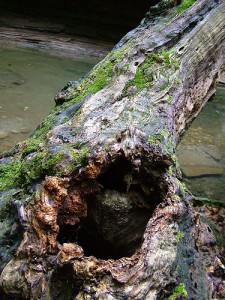Oudh, also known as agarwood or aloeswood, is a rare and wonderful aromatic wood used in incense making. It originated in Assam, and then spread throughout Asia. The precious resin is created when the heart wood of the evergreen tree is infected with a very specific mold. Because of the very specific conditions in which it is created, and because the mold eventually kills the tree, it’s incredibly rare, and good quality oudh is more costly than its same weight in gold. The process of infection, and the subsequent buildup of the resin created as a result can take up to 100 years to create the highest quality, most saturated heartwood that produces the most expensive oils and incenses.

I had read about agarwood incenses as part of my study into incense traditions. There is a strong presence of agarwood in Japanese incense rituals, and there are even special incense heaters like the Electric Wood Chip and Pressed Incense Heater by Shoyeido
that can be purchased to burn high quality agarwood in a way that will release the scent without actually ‘burning’ it, which can ruin some of the more delicate scent notes. The oil is also used in very high-end perfumes, none of which I’ve had the opportunity to sample.
I did purchase Nandita Dehn Al Oudh Incense, and was excited to try it, though I knew that it wouldn’t be terribly high quality at the price I paid. Honestly? It’s not bad though. It is vaguely reminiscent of the softness of sandalwood, but with a slightly astringent top note. I’m usually not into astringent incense ingredients, I avoid frankincense whenever possible, so it’s not my favorite. I would love to get the chance to try some higher quality varieties, though chances are, they’re cost prohibitive.
The magickal properties of agarwood are those of meditation, helping one to achieve higher states of consciousness than would be possible otherwise. It’s used to neutralize negative energy during magickal workings, and is also used as an aphrodesiac. The reason for this is that there are compounds in the resin that mimic pheremones.
This is another one of those incense ingredients where you need to do your research before you purchase it. A lot of oudh is harvested from plantations, where the trees are grown for the specific purpose of being infected with the particular fungus that helps to create the fragrant resin. However, there is a lot of wild harvesting of oudh, driven by greed, which is contributing to the depletion of the species. Most of the plantation grown varieties are found in Vietnam and the Phillippines. So try to be as sure as possible what you’re buying. Personally, I’ve always felt that magickal ingredients that are harvested irresponsibly are kind of an insult to Gaia, and a great way to be ignored by the universe.